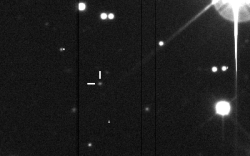Megaclite
Megaclite /mɛɡəˈklaɪtiː/, also known as Jupiter XIX, is a natural satellite of Jupiter. It was discovered by a team of astronomers from the University of Hawaii led by Scott S. Sheppard in 2000, and given the temporary designation S/2000 J 8.[3][1][4]
 Megaclite imaged by the Canada-France-Hawaii Telescope in December 2001 | |
| Discovery[1] | |
|---|---|
| Discovered by | Scott S. Sheppard et al. |
| Discovery site | Mauna Kea Obs. |
| Discovery date | 25 November 2000 |
| Designations | |
Designation | Jupiter XIX |
| Pronunciation | /mɛɡəˈklaɪtiː/ |
Named after | Μεγακλειτή Megaclītē |
| S/2000 J 8 | |
| Adjectives | Megaclitean /ˌmɛɡəklɪˈtiːən/ |
| Orbital characteristics [2] | |
| 23806000 km | |
| Eccentricity | 0.421 |
| −752.8 days | |
| Inclination | 152.8° |
| Satellite of | Jupiter |
| Group | Pasiphae group |
| Physical characteristics | |
Mean diameter | 6 km |
| 21.7 | |
Megaclite is about 6 kilometres in diameter, and orbits Jupiter at an average distance of 24,687,000 kilometers in 792.437 days, at an inclination of 150° to the ecliptic (148° to Jupiter's equator), in a retrograde direction and with an eccentricity of 0.308.
It was named in October 2002 after Megaclite, mother by Zeus (Jupiter) of Thebe and Locrus in Greek mythology.[5][6]
It belongs to the Pasiphae group, irregular retrograde moons orbiting Jupiter at distances ranging between 22.8 and 24.7 Gm, and with inclinations ranging between 144.5° and 158.3°.
References
- MPEC 2001-A29: S/2000 J 7, S/2000 J 8, S/2000 J 9, S/2000 J 10, S/2000 J 11 2001 January 15 (discovery and ephemeris)
- S.S. Sheppard (2019), Moons of Jupiter, Carnegie Science, on line
- IAUC 7555: Satellites of Jupiter Archived 2002-09-16 at the Wayback Machine 2001 January 5 (discovery)
- MPEC 2001-T59: S/2000 J 8, S/2000 J 9, S/2000 J 10 2001 October 15 (revised ephemeris)
- IAUC 7998: Satellites of Jupiter 2002 October 22 (naming the moon "Magaclite")
- IAUC 8023: Satellites of Jupiter 2002 November 29 (correcting the name)